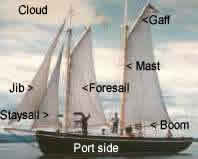







The Voyage of the Alamar
Capt. Bob would like his crew to become proficient in a couple of marine skills.
 Lines and Knots - First of all, there are almost no "ropes"
on a boat. You can pretty much throw the word "rope" overboard.
Sailors use "lines," which may explain why they're adept at
picking up girls when ashore.
Lines and Knots - First of all, there are almost no "ropes"
on a boat. You can pretty much throw the word "rope" overboard.
Sailors use "lines," which may explain why they're adept at
picking up girls when ashore.
Thank goodness "knots" are still "knots." But we don't normally "tie" knots; we "make" them, and we don't tie things together so much as "make them fast." Don't tie the boat to the dock, make it fast to the dock. But if you want to tie one on, no one will complain.
Click here for tips on lines and knots
 Sails and terminology
- Other than lines and knots, there are a few other bits
of terminology that come in handy.
Sails and terminology
- Other than lines and knots, there are a few other bits
of terminology that come in handy.
- Fore and aft - Front and back of the boat (but you knew that)
- Port and Starboard - As you face forward, port is on your left and starboard is on your right. The easy way to remember this, if you're right-handed, is that right is the "star" side. Since I'm right-handed, I don't know the memory trick for lefties. The reason we use "port" and "starboard" rather than left and right is that the sides stay the same when you turn around and face aft. Port is now on your right and starboard is on your left. So the starboard side of the boat is always the same physical place.
- Our boat is a "schooner" because it has more than one mast and the foremast is shorter than the aft one. You most commonly see "sloops" today, which are single-masted boats.
- She's "gaff rigged" because the primary sails have a trapezoidal shape and a pole at the top (called a "gaff"), rather than being simple triangles. The rig you commonly see today, with triangular sails, is called a "Marconi rig." Those modern Marconi-rigged sloops are better going upwind, but we can lick them heading downwind.
- The "mainsail" is the one on the taller, aft mast.
- The "foresail" is the one on the shorter, foremast.
- The other two sails both "stay sails," meaning they don't go up a mast. More particularly, the forward one is the "jib" and the aft one being simply the "staysail."
If you really want to get into this, here's a full Glossary
.gif) Boxing the Compass - One way of reading a compass is by
degrees - North is 0° and South is 180°, for example. But mariners
have long used another system that relies on "points" of the
compass. The cardinal points are your familiar North (N), East (E), South
(S) and West (W). But there are seven quarter-points between each of these,
all with special names like ENE or N by E.
Boxing the Compass - One way of reading a compass is by
degrees - North is 0° and South is 180°, for example. But mariners
have long used another system that relies on "points" of the
compass. The cardinal points are your familiar North (N), East (E), South
(S) and West (W). But there are seven quarter-points between each of these,
all with special names like ENE or N by E.
Click here for a guide to this system.